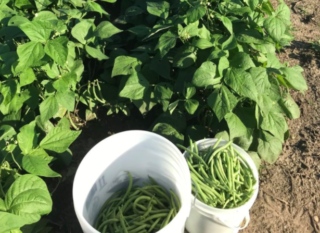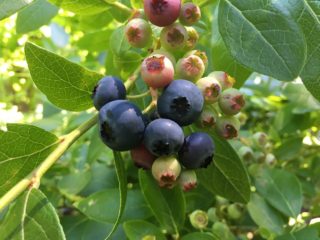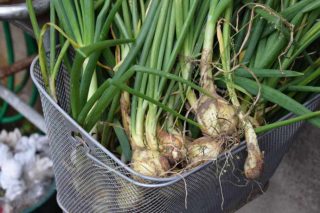It’s curd. A plantain. It’s a superfood! You may not be able to leap tall buildings, but “superfood” — the nickname given to nutrition-packed fruits and vegetables — offers extraordinary health benefits. You don’t need to travel far to find them, especially if you learn to grow your own. Fruits and vegetables grown at home are fresh, organic, and lose nothing in shipping. Add in the physical and mental benefits of gardening, and you have a winner. Here’s the lowdown on how to grow your own superfood garden.
Lay Some Groundwork for your superfood garden
Great gardens don’t just happen; they are the product of strategic planning. Before you consider what you want to grow in your superfood garden, you must determine your growing zone. From there, consult the list of superfoods below and find varieties of each that are suited to your area.

Draft a Plan
Use graph paper and a ruler to make a drawing of your garden plot to scale. Take the mature dimensions of your desired plants and map out where they should go. This helps you determine exactly how much space they need to avoid overcrowding later. Rather than dedicating beds or rows to single varieties, alternate plant types for increased vigor and pest resistance. Plant trees on the northern edge of the garden where they won’t cast long shadows over the beds.
Choose your Superstars
These are some superfoods that you can grow at home. Source your seeds, rootstock, or starts, from an organic, non-GMO source.
Blackberries and Blueberries

These sweet treats are brimming with antioxidants and phenolic compounds that protect the brain from aging. Blackberry canes need a fence or trellis to climb, and blueberry bushes require acidic soil to thrive.
Cruciferous vegetables in your superfood garden
The veggie family is full of superfood stunners: broccoli, brussels sprouts, collard greens, and kale. Their powerful compounds (carotenoids, vitamin C, sulforaphane, and omega-3 fatty acids) reduce inflammation, improve skin tone, and are heart-healthy. No wonder we’re so obsessed with kale!

Legumes
Peas and beans are cholesterol-busting foods that can also help manage diabetes. They’re also delicious and versatile. You can eat them fresh or harvest them and can or store them in dried form for future use.
Tomatoes
A sneaky superfood that we tend to take for granted, tomatoes are rich in vitamin C, lycopene, and potassium. With brain and nerve-protective qualities and the ability to improve sleep and memory, this garden staple is a must-have. Even better? Lycopene levels increase with cooking, so sauce away!
Roots, Bulbs, and Tubers
These subterranean superfoods grow out of sight. Garlic, onions, ginger, and turmeric are nutrient-dense, distinct-tasting, and easily overlooked as seasonings. Another unsung superfood hero is the humble sweet potato. The green plants are tasty, nutritious, and able to withstand even the hottest summer days.

Herbs and Flowers
The same compounds that give culinary herbs their remarkable flavors also give them superfood qualities. Cilantro, mint, and parsley are all nutritional heavy-hitters in their own right. Towering sunflowers yield seeds that support the nervous system and heart functions. It may come as some surprise, but dandelions are a secret superfood too often treated as a weed. Incorporating culinary herbs and flowers into your garden can improve the health of your vegetables and add some cheer to the beds.
Bottom Line
Creating your own superfood garden may not make you faster than a speeding bullet, but it will make it easier to enjoy their health benefits. You’ll have no excuse not to eat healthy since you’ll have fresh produce at your fingertips whenever you like. When it comes to enhancing your day-to-day health, creating your own superfood supply makes perfect sense.
References:
Miller, M., Shukitt-Hale, B. (2012). Berry fruit enhances beneficial signaling in the brain. J Agric Food Chem. 13;60(23):5709-15. doi: 10.1021/jf2036033 https://www.ncbi.nlm.nih.gov/pubmed/22264107
Story, E. N., Kopec, R. E., Schwartz, S. J., & Harris, G. K. (2010). An update on the health effects of tomato lycopene. Annual review of food science and technology, 1, 189–210. https://doi.org/10.1146/annurev.food.102308.124120
Šamec D., Urlić B., Salopek-Sondi B. (2019) Kale (Brassica oleracea var. acephala) as a superfood: Review of the scientific evidence behind the statement. Crit Rev Food Sci Nutr. 2019;59(15):2411-2422. doi: 10.1080/10408398.2018.1454400 https://www.ncbi.nlm.nih.gov/pubmed/29557674
Bazzano, L. A., Thompson, A. M., Tees, M. T., Nguyen, C. H., & Winham, D. M. (2011). Non-soy legume consumption lowers cholesterol levels: a meta-analysis of randomized controlled trials. Nutrition, metabolism, and cardiovascular diseases : NMCD, 21(2), 94–103. https://doi.org/10.1016/j.numecd.2009.08.012
About the author
Victor Wang grew up in Central California plucking tomato worms from his mother’s heirloom tomato garden, and is now a master gardener and freelance writer. His areas of expertise include landscaping, organic pest control and, of course, gardening.
Do you love gardening, but don’t have the space? Then think vertical gardening. Here’s how.



![women [longevity live]](https://longevitylive.com/wp-content/uploads/2020/01/photo-of-women-walking-down-the-street-1116984-100x100.jpg)










